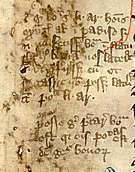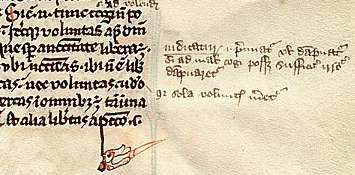 |
The glosses are written in a very tiny, fine and spidery cursiva anglicana script. This is a segment from the left hand margin of the recto. Unfortunately, the leaf is damaged. It looks as if the spine of the original book may have got damp at some stage, and the edge is marked and full of holes and has been rather clumsily repaired by glueing a paper strip down the verso of the leaf. This makes the gloss along the left hand margin of the recto rather difficult to make out, and actually obliterates it partially in the right hand margin of the verso. |
| The gloss consists in some places of single words, in others of very brief and enigmatic abbreviations, and in others of more extensive notes. Some of the brief ones are corrections to the text. While it looks like a single hand to a mere amateur like me, some parts are smaller and finer than others, as if written with a different pen. I would suggest, my dear Watson, that this might imply that parts had been added at different times, as the text was repeatedly read. The size and fineness of the glossing script suggests a couple of questions. Firstly, did medieval theological scholars have incredible eyesight, or did they use some sort of magnifying system to write with? I need a magnifying glass to read it, even with my hi-tech modern mulitfocals. Secondly, what did they write with on these occasions? Somehow I cannot see it as being with a pen made from the strong flight feather of a goose. It is clearly a split nib and the whole style of the writing is similar to that used in more robust writings, so did they use tiny little feathers, or just cut the nibs on larger quills very, very fine or use something else like a reed pen, as they used in antiquity? (No, I don't have to provide all the answers. I can ask questions too.) |
 |
| The above shows shows a little bit of interlinear gloss and a segment of marginal gloss from the right hand side of the recto of the leaf. As you can see, it is highly abbreviated. I can make out the whole words ad (twice) and gratuita. |
 |
This is one of my favourite bits. The little pointer presumably indicates that this piece of marginal gloss, in the right margin at the bottom of the recto, is particularly significant. I presume it is meant to be a hand holding the pointer, but it does look a bit like a dog's head .... sort of. |
| The p in the last line of the text shows a long wiggly descender, as found in several letters along the bottom lines. |
 |
| Above is an enlarged sample from an extensive gloss in the broad lower margin of the verso. just so that you can pick out the features of the cursiva anglicana script. Note the double chambered a, the closed curly d, the closed g like a figure of eight, the open r which extends below the line, and the short s which is very cursive and open at the top. Yes, you can. Just look carefully. This script will not be dealt with in the rest of the paleography exercise, which will concentrate on the textura of the main text. We might deal with this one on another day. Maybe. |
|
Sentences of Peter Lombard. From a private collection. Photographs © Dianne Tillotson. |
|
|
overview | initials | text
| glosses | alphabet | abbreviations
| exercises | transcript
| translation
| |
|
Click
on each of the above to walk your way through the text. The transcript
will appear in a separate window so that you can use it for reference
at any time. These exercises are designed to guide you through the text,
not test you, so you can cheat as much as you like. |
|
 Script sample for this example Script sample for this example |
 Index
of Exercises Index
of Exercises |
 Index
of Scripts Index
of Scripts |
|
 |
 |
 |